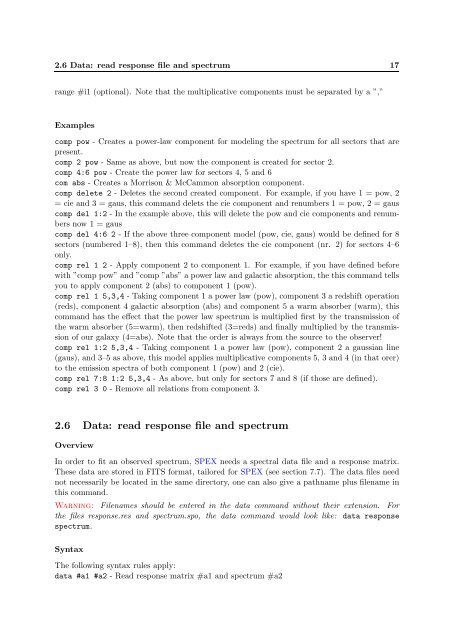SPEX Reference manual (PDF) - SRON
SPEX Reference manual (PDF) - SRON
SPEX Reference manual (PDF) - SRON
You also want an ePaper? Increase the reach of your titles
YUMPU automatically turns print PDFs into web optimized ePapers that Google loves.
2.6 Data: read response file and spectrum 17<br />
range #i1 (optional). Note that the multiplicative components must be separated by a ”,”<br />
Examples<br />
comp pow - Creates a power-law component for modeling the spectrum for all sectors that are<br />
present.<br />
comp 2 pow - Same as above, but now the component is created for sector 2.<br />
comp 4:6 pow - Create the power law for sectors 4, 5 and 6<br />
com abs - Creates a Morrison & McCammon absorption component.<br />
comp delete 2 - Deletes the second created component. For example, if you have 1 = pow, 2<br />
= cie and 3 = gaus, this command delets the cie component and renumbers 1 = pow, 2 = gaus<br />
comp del 1:2 - In the example above, this will delete the pow and cie components and renumbers<br />
now 1 = gaus<br />
comp del 4:6 2 - If the above three component model (pow, cie, gaus) would be defined for 8<br />
sectors (numbered 1–8), then this command deletes the cie component (nr. 2) for sectors 4–6<br />
only.<br />
comp rel 1 2 - Apply component 2 to component 1. For example, if you have defined before<br />
with ”comp pow” and ”comp ”abs” a power law and galactic absorption, the this command tells<br />
you to apply component 2 (abs) to component 1 (pow).<br />
comp rel 1 5,3,4 - Taking component 1 a power law (pow), component 3 a redshift operation<br />
(reds), component 4 galactic absorption (abs) and component 5 a warm absorber (warm), this<br />
command has the effect that the power law spectrum is multiplied first by the transmission of<br />
the warm absorber (5=warm), then redshifted (3=reds) and finally multiplied by the transmission<br />
of our galaxy (4=abs). Note that the order is always from the source to the observer!<br />
comp rel 1:2 5,3,4 - Taking component 1 a power law (pow), component 2 a gaussian line<br />
(gaus), and 3–5 as above, this model applies multiplicative components 5, 3 and 4 (in that orer)<br />
to the emission spectra of both component 1 (pow) and 2 (cie).<br />
comp rel 7:8 1:2 5,3,4 - As above, but only for sectors 7 and 8 (if those are defined).<br />
comp rel 3 0 - Remove all relations from component 3.<br />
2.6 Data: read response file and spectrum<br />
Overview<br />
In order to fit an observed spectrum, <strong>SPEX</strong> needs a spectral data file and a response matrix.<br />
These data are stored in FITS format, tailored for <strong>SPEX</strong> (see section 7.7). The data files need<br />
not necessarily be located in the same directory, one can also give a pathname plus filename in<br />
this command.<br />
Warning: Filenames should be entered in the data command without their extension. For<br />
the files response.res and spectrum.spo, the data command would look like: data response<br />
spectrum.<br />
Syntax<br />
The following syntax rules apply:<br />
data #a1 #a2 - Read response matrix #a1 and spectrum #a2

















